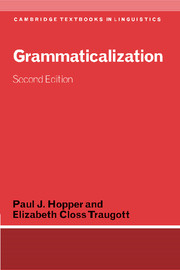Book contents
- Frontmatter
- Contents
- List of figures
- List of tables
- Preface and acknowledgments
- List of abbreviations
- 1 Some preliminaries
- 2 The history of grammaticalization
- 3 Mechanisms: reanalysis and analogy
- 4 Pragmatic factors
- 5 The hypothesis of unidirectionality
- 6 Clause-internal morphological changes
- 7 Grammaticalization across clauses
- 8 Grammaticalization in situations of extreme language contact
- 9 Summary and suggestions for further work
- Notes
- References
- Index of names
- Index of languages
- General index
Preface and acknowledgments
Published online by Cambridge University Press: 05 June 2012
- Frontmatter
- Contents
- List of figures
- List of tables
- Preface and acknowledgments
- List of abbreviations
- 1 Some preliminaries
- 2 The history of grammaticalization
- 3 Mechanisms: reanalysis and analogy
- 4 Pragmatic factors
- 5 The hypothesis of unidirectionality
- 6 Clause-internal morphological changes
- 7 Grammaticalization across clauses
- 8 Grammaticalization in situations of extreme language contact
- 9 Summary and suggestions for further work
- Notes
- References
- Index of names
- Index of languages
- General index
Summary
When we wrote the first edition of this book in the early 1990s, our aim was to present an overview of grammaticalization for the benefit of those students of linguistics to whom this was a new or only vaguely familiar framework for understanding linguistic phenomena. We defined grammaticalization as the process whereby lexical items and constructions come in certain linguistic contexts to serve grammatical functions, and, once grammaticalized, continue to develop new grammatical functions. We also characterized it as the process whereby the properties that distinguish sentences from vocabulary come into being diachronically or are organized synchronically. In the last ten years grammaticalization has become a major field of study, and work on the topic has flourished in both “functional” and “formal” frameworks, that is, on the one hand frameworks that privilege the interplay of language structure and use and consider language as both a cognitive and a communicative force, and on the other frameworks that privilege language structure and consider language primarily from the perspective of internalized systems. As work has progressed, it has become clear that the definition of grammaticalization as a “process” has been misleading. To some it has suggested that grammaticalization is conceived as a force with an impetus of its own independent of language learners and language users. This was never intended. Only people can change language.
- Type
- Chapter
- Information
- Grammaticalization , pp. xv - xviiPublisher: Cambridge University PressPrint publication year: 2003

